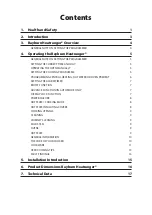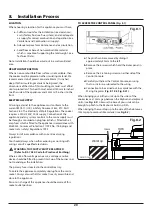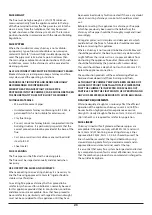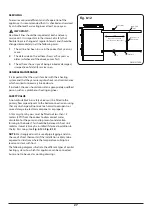
13
USER COOKING TIPS
You will soon come to look upon the Rayburn as a reliable
companion to help you during a busy baking session or when
you are preparing that extra-special meal. The following tips
are ways in which you will find the Rayburn invaluable: no
doubt you will quickly add discoveries of your own to the list.
1.
Baking: If you are using butter or margarine from the
refrigerator, simply place the required amount of fat in
a heatproof bowl on the hob, near to the hotplate. It
will be quickly brought to room temperature, making it
easier to work with.
2.
Breadmaking: Stand the required liquid for the recipe
in a heatproof jug on the hob near the hotplate to
warm. Take care not to overheat as yeast is killed at high
temperatures.
3.
Breadmaking: Depending on what mode the cooker is
set at, the hob, plate rack or lower oven can be used for
proving the dough.
4.
Baking: To dissolve gelatine, place two tablespoons
of water or liquid from the recipe in a small heatproof
bowl. Sprinkle the required amount of gelatine on the
liquid and place on or near the hotplate to dissolve. A
small stainless steel bowl is useful for this type of job.
5.
Baking: When melted chocolate is needed in a recipe
or for decoration work, simply place the chocolate in a
heatproof bowl near the hotplate. This method is easier
than placing over a pan of hot water, which can often
splash into the chocolate and spoil it.
6.
Baking: Syrup tins and jam jars with only a little left in
them are easier to empty when they have warmed on
the hob.
7.
Cooking: If a recipe requires a small amount of fried or
softened onion, place the finely chopped onion and
a little butter or oil in a heatproof bowl on or near the
hotplate to soften. I use this method often, because it
is so much easier than having to wash up a frying- pan!
Many different types of vegetables can be prepared this
way before adding to a recipe.
8.
Cooking: To make breadcrumbs, simply place the bread
on a baking sheet in the lower oven and allow to dry
out. Crush and store for future use.
9.
Cooking: To make croutons, cut the bread into small
cubes, place in a shallow cast iron dish with a little oil
and fry, using the base of the main oven. (If the oven
is not in use, fry on the hotplate) Drain, spread out
on a baking sheet and put to crisp in the lower oven.
Croutons can be frozen for use when required.
10.
Drying: An abundance of fresh herbs need not be
wasted. Place on a baking sheet, after washing and
patting dry with kitchen paper, and leave to dry in the
lower oven. Store for future use.
11.
Drying: Cooker rice can be spread out on a baking sheet
and left to dry in the lower oven.
12.
Baking: When making fruit cakes, wash the dried fruit,
place on a baking sheet and allow to dry off in the lower
oven before use. Moist fruit will sink to the bottom of a
cake and spoil it.
13.
Preserving: When you are bottling, the depth of the
main oven makes it easy to sit a tray of bottled fruit all
on the same shelf to cook in one session.
14.
Preserving: When you are making jam the graduated
hotplate enables you to control the simmering of
a large preserving pan much more easily than on a
conventional cooker, where the pan is too large for
the burner or ring. The warming of sugar, drying of the
prepared fruit and the warming of jars and bottles can
all be done with plenty of space using the lower oven
and plate rack, if you have one.
















































